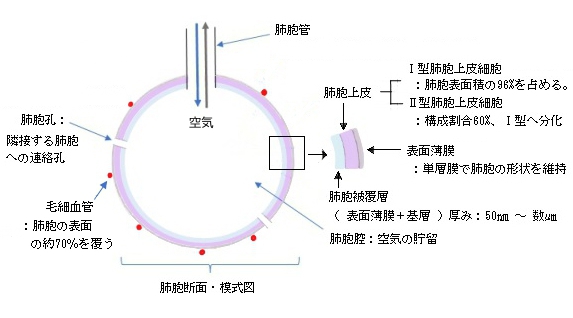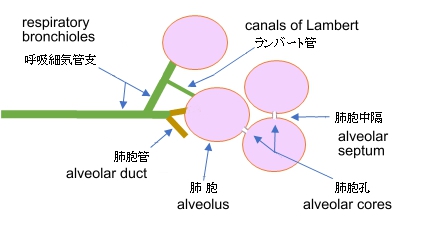
・コーンの孔とも。
以下は「Wikipedia」の解説文の主なポイントを要約したものになる。
・通常、Ⅱ型肺胞上皮細胞がその形成に関わる。
・新生児では欠如し、3,4歳くらいから徐々にその発達が見られる。
・肺胞孔を通して物質(液体、バクテリアなど)のやり取りが行われる。
・肺胞孔で隣接する肺胞と通じ合うことで肺胞内の内圧を均一化している。


以下は「Wikipedia」の解説文となる。
The pores of Kohn (also known as interalveolar connections or alveolar pores) are discrete holes in walls of adjacent alveoli. Cuboidal type II alveolar cells, which produce surfactant, usually form part of aperture.
【Etymology】
The pores of Kohn take their name from the German physician and pathologist Hans Nathan Kohn (1866–1935) who first described them in 1893.
【Development】
They are absent in human newborns. They develop at 3–4 years of age along with canals of Lambert during the process of thinning of alveolar septa.
【Function】
The pores allow the passage of other materials such as fluid and bacteria, which is an important mechanism of spread of infection in lobar pneumonia and spread of fibrin in the grey hepatisation phase of recovery from the same. They also equalize the pressure in adjacent alveoli and, combined with increased distribution of surfactant, thus play an important role in prevention of collapse of the lung.
Unlike adults, in children these inter-alveolar connections are poorly developed which aids in limiting the spread of infection. This is thought to contribute to round pneumonia.
【語句】
・discrete:別々の ・adjacent:隣接した ・surfactant:界面活性剤 ・aperture:開き口 ・pathologist: ・canals of Lambert:ランバートの管 ・alveolar septa:肺胞中隔 ・lobar pneumonia:肺炎の一種 ・grey hepatisation phase:肺炎の進行段階の1つ
■ 写真やイラストを掲載しているサイト ■
・ イラストや写真を掲載しているサイト-Ⅰ
・ イラストや写真を掲載しているサイト-Ⅱ
・ イラストや写真を掲載しているサイト-Ⅲ
・ イラストや写真を掲載しているサイト-Ⅳ

|